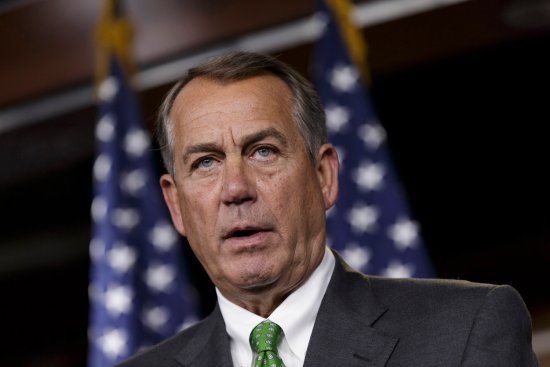
The House GOP increased its majority by at least 11 seats
The House has been a bit neglected during the 2014 election midterms—and for good reason. The question was never who would control the majority, but how many more seats would Speaker Boehner carry.
There wasn’t the drama of the Senate or even the governors’ races, but on Tuesday, House Republicans appeared set to increase their majority to the largest its been since 1946 by capturing at least 11 seats. The wins were even more impressive considering there were only around 40 competitive seats this cycle out of 435 total.
As expected, the national climate proved favorable to Republicans. Consider the races of New York Republican Rep. Michael Grimm, Democratic Georgia Rep. John Barrow and West Virginia Democratic Rep. Nick Rahall.
Staten Island representative Grimm, a former Marine and FBI agent, who is facing a 20-count federal indictment and earlier this year he threatened to break a reporter in half “like a boy” on camera, prevailed with 55 percent of the vote. On Saturday, the New York Daily News gave an already infamous endorsement digging the IQ of Democrat Domenic Recchia: “At least Michael Grimm can string three sentences together in arguing that he deserves the presumption of innocence on federal criminal charges stemming from his past operation of a restaurant.”
There are no more white House Democrats in the Deep South now that Republican businessman Rick Allen beat Barrow, who lost his bid for a sixth term representing eastern Georgia for a variety of reasons, including a redrawn district and the usual midterm demographic challenges. Barrow was praised, however, for his creative ads. “Anybody who says John Barrow isn’t getting things done is lying like a no-legged dog,” says a woman in one this year.
Rahall, who has been in Congress for 38 years, was also not so lucky and lost to state senator Evan Jenkins. The President’s approval rating in West Virginia is in the 20s and the state elected Shelly Moore Capito, its first female senator ever, and its first Republican in 56 years.
In a press conference Tuesday night, Rep. Steve Israel, the Chairman of the Democratic Congressional Campaign Committee, repeatedly reminded reporters at their headquarters in Washington D.C. of the “echo of history”: the president’s party loses on average 29 House seats during midterm elections. “This is indisputably a very tough terrain,” he said.
Photos: Meet America’s 10 Newest Senators
[time-brightcove not-tgx=”true”]









Of course, there were some exceptions. Democrat Gwen Graham, a strong campaigner with a sterling political background (she’s the daughter of former Democratic Sen. and Gov. Bob Graham) and a big, nearly $1 million boost from House Majority PAC, beat Republican Congressman Steve Southerland in one of the most expensive races in the country. Southerland, who’s known for his efforts to overhaul the food stamp program was ridiculed for hosting an all-male fundraiser this cycle.
Republicans will continue to have an issue with diversity. The House GOP gap with women and minorities is likely to become even larger, according to Dave Wasserman, a House election analyst for the nonpartisan Cook Political Report. “The demographic gap between the two parties in the House is likely to reach a new record high,” he wrote Monday. He noted that in 2012, white men became a minority of the Democratic caucus for the first time, while 89 percent of House Republicans remain white men.
Still, there were a few big wins for Republican female candidates: At 30, New York Republican Elise Stefanik will become the youngest woman to become a Congresswoman and Mia Love of Utah could be the first black Republican woman in Congress. (Polls showed a slight Love lead after midnight.)
The major question now is what Republicans will do with control of both houses. In a statement Tuesday, Boehner wrote that Congress will “debate and vote soon” on jobs and energy bills stalled by Senate Majority Leader Harry Reid and the Democrats. Many Republicans are looking forward to the extra breathing room in passing legislation, as Boehner will have an easier time obtaining 218 votes despite new Tea Party types.
“The governing coalition, those who want to solve problems and advance common sense proposals that can receive bipartisan support at home, is going to grow even larger,” says Rory Cooper, the former communications director for the recently retired Majority Leader Eric Cantor. “Whenever you have more Republican members, it will be easier for leadership to pass conservative priorities by simple math.”
Other Republicans are wary of new rabble-rousers, who may look to be even more ambitious with a new Senate majority that is still under the 60 votes needed to pass most legislation.
Ron Bonjean, the communications director to former House Speaker Dennis Hastert, says that there could be some governing problems with an enlarged majority. “The first is setting the expectation level with the Republican House members about how much the Senate Republican conference can achieve with their majority,” he says. “That is the biggest challenge they’ll face.”
What is absolutely clear is that expanding the House GOP’s hold was widely expensive. House races ran 481,300 ads to the tune of nearly $235 million, according to the Wesleyan Media Project, and that’s just through October 23. House Republican and Democratic candidates are expected to spend around $941 million overall this cycle, according to the Center for Responsive Politics, and tens of millions more were spent by outside groups and the parties.